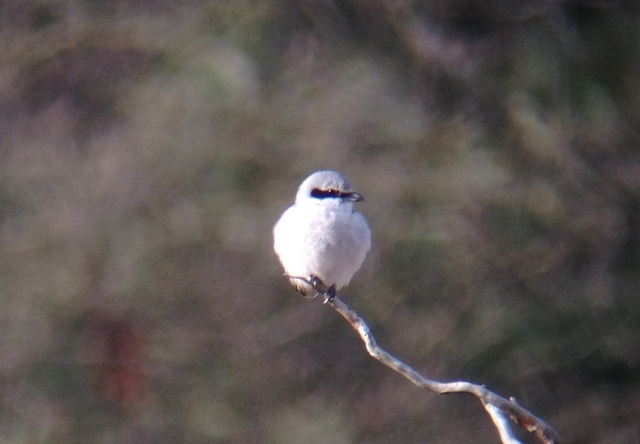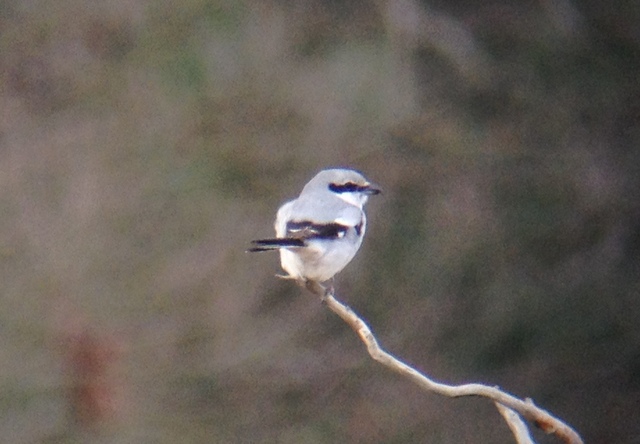It was time for a Brecks Tour today. With the tabloid headlines proclaiming an icy chill from Siberian winds, it wasn’t a promising outlook. But as ever, we were not put off by the weather – and the sun even shone for a while today!
We started at Lynford Arboretum. Nuthatches, Treecreepers and Goldcrests were singing and calling around the car park. Lots of Siskin were whizzing round the tree tops as we walked across to the arboretum, and several perched up briefly in the larches for us to get a good look at them.
After a dry couple of days, the finches were making an early start and were already feeding down amongst the leaves by the gate. There were several Chaffinches down on the ground but a couple of people standing there had seen no sign of the Hawfinches. As so often happens, they were looking in the wrong place! A short distance away, a male Hawfinch was down amongst the leaves, with several Bramblings next to it. We got a quick look at the Hawfinch, a smart male, before it was spooked and flew up into the trees. We could still hear it calling from above and a little further along we managed to find it sitting in the bare treetops. We got a good view of it through the scope before it dropped back down.
There were lots of other birds around the clearing – a Great Spotted Woodpecker perched in the top of a fir tree, a small group of Bullfinches fed on the buds in the bushes including a couple of smart pink males, several more Siskin flew in and a male Brambling appeared in the treetops.
One of the gathering crowd by the gate kindly came over to tell us that a Hawfinch was back on the ground, so we walked back quietly to have a good look. The male was down in the leaf litter and we got great views of it – its enormous bill, its bright chestnut head and contrasting grey nape.
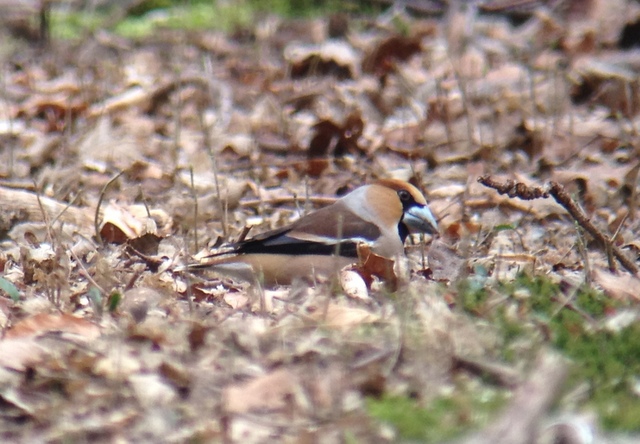 Hawfinch – a male, stunning views again today
Hawfinch – a male, stunning views again today
Most of the people drifted away and suddenly a female Hawfinch dropped down only a short distance in front of us. Wow – what views! She fed on the seed on the ground amongst the Chaffinches for several minutes. It was great to compare her to the male, the much greyer brown body plumage, lacking the rich browns and chestnuts of her partner.
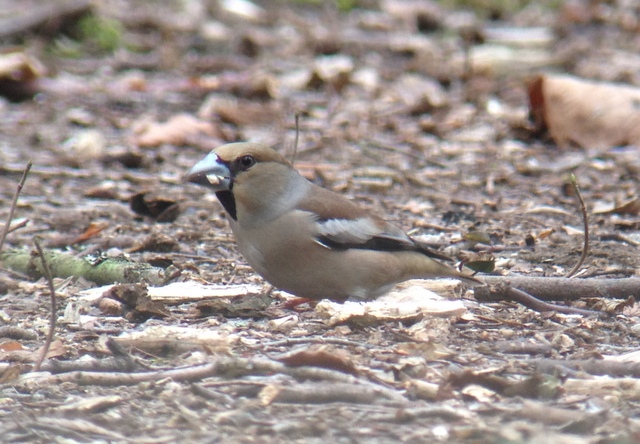 Hawfinch – the females are a much duller mix of grey-brown tones
Hawfinch – the females are a much duller mix of grey-brown tones
It was also good to see her next to the Chaffinches. Hawfinches are big birds – for a finch – and a lot chunkier than their cousins!
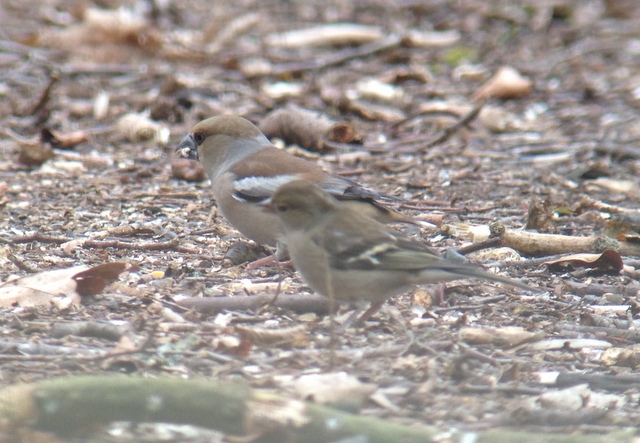 Hawfinch – head & shoulders above the Chaffinches!
Hawfinch – head & shoulders above the Chaffinches!
When something spooked the two Hawfinches we decided it was time to explore the Arboretum, but only a little further on we could see them back up in the trees. We had to stop and look again. Then another Hawfinch appeared, then another. There were at least four of them flicking round in the trees. A great way to start the day.
We eventually tore ourselves away and went to explore the rest of the Arboretum. It was cold, much colder than recent days, and as a consequence activity levels were much reduced. There were fewer birds singing than previous days and no sign of the Hawfinches which had been singing and feeding around the Arboretum. Still, there were things to see – a variety of tits, Nuthatches, Treecreepers, Goldcrests. A Redpoll flew overhead, calling. Round by the edge of the Battle Area, we could hear and see a few Redwings in the tops of the trees, but as we walked on more and more of them flew up out of the bushes.
With time getting on, we decided to head on to look for Goshawks. This was always going to be the most challenging target today and raptor activity levels were distinctly down on recent days in the biting wind. There were still plenty of Common Buzzards circling up, though not as many (or as high) as usual. A Red Kite came in low over the trees. A Kestrel hovered over the fields. The odd Sparrowhawk circled up and we did spot a pair displaying briefly away to the east. Eventually, a Goshawk came up, but it stayed low and flew away west hugging the treetops. A while later, another bird circled up distantly to the north, flashing silvery grey above and very pale,white below.
We decided to try another site, deeper in the Forest, to see if there might be more shelter – and activity. We walked in through the trees, but as we reached the clearing we found that the ‘Siberian’ wind was still whistling across the open expanse. A Common Buzzard appeared down one of the rides, clearly trying to hunt out of the wind, before circling up over the clearing, joined by a second. A Kestrel hovered out in front of us. But that was it, raptor-wise – no sign of the Goshawks, frustratingly close by but out of sight.
There was one compensation – several Woodlarks were singing and flying around the clearing and a pair of Woodlarks were in their usual place by the path. They seemed a bit jumpy in the wind, and flushed ahead of us as we walked over, much earlier than they would normally. However, we waited and let them settle, feeding in the lee of a deer fence, before we edged our way closer. Eventually we got great views of them and the photographers got some great photos.
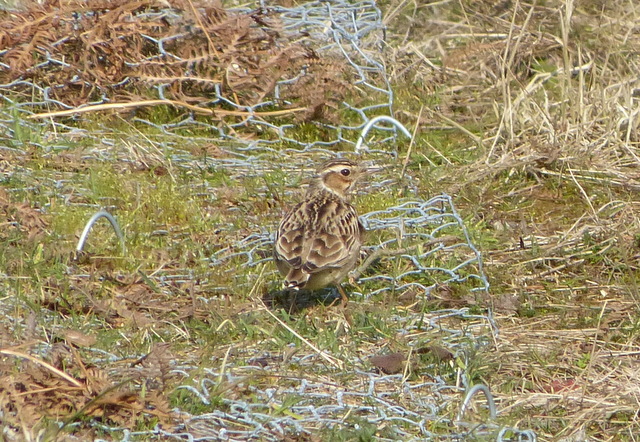 Woodlark – a pair fed along the sheltered edge of the deer fence
Woodlark – a pair fed along the sheltered edge of the deer fence
From there, we headed over Lakenheath Fen to have a quick look round and use the facilities. We didn’t have enough time to walk out onto the reserve today, but wanted to take a look at Hockwold Washes. Through the visitor centre, we stopped briefly to admire the feeders – as we walked out, several Reed Buntings flew out from the reeds.
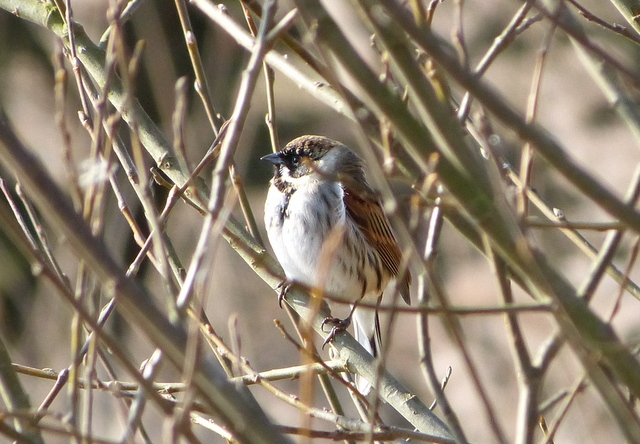 Reed Bunting – there were several around the feeders again
Reed Bunting – there were several around the feeders again
From up on the river bank at the Washland viewpoint, we immediately found a problem – fishermen. The Great White Egrets have regularly been feeding along the edges of the river and on the pools and flashes on either side. However, from just where we were standing we could see that there were two fishermen right down amongst the vegetation on the reserve side, just where one of the egrets favours, and three more around the pools further west. We spoke to reserve staff later and they confirmed that the warden had already told fishermen to at least move off the reserve, but they had either ignored the advice or returned. We also spoke to someone walking back along the river bank and they confirmed that there was no sign of any of the egrets all along the riverbank.
The Little Egrets were not put off – with the water level dropping, there were at least 10 out on Hockwold Washes, but none of their larger brethren. A couple of smart Great Crested Grebes swam along the river. Several Snipe flew over and dropped into the rushes. A Cetti’s Warbler sang loudly from deep within the bushes.
There were lots of ducks out on the Washes – a good selection of Wigeon, Teal, Mallard, Gadwall, Shoveler, Tufted Ducks, and… what’s that? While scanning through the throng, we picked up another duck amongst them, a very smart drake Garganey. It was initially out on the Washes but swam into the near bank out of view before we suddenly found it again on the river right in front of us. What a stunner! Garganey are very pretty ducks (drakes!), small – only a little bigger than a Teal, and summer visitors or migrants to our shores. We could see its striking white supercilium, grey flanks with striking elongated scapulars overhanging, and pale grey forewing in flight as it flew back to the Washes.

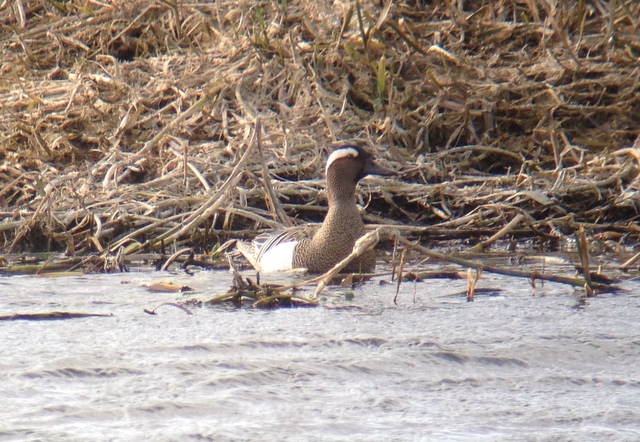 Garganey – this smart drake was on Hockwold Washes today
Garganey – this smart drake was on Hockwold Washes today
We were about to give up and move on, when all the ducks, geese, swans, coots, etc scattered across the Washes. A quick scan revealed a young Peregrine coming in from the west. It made a pass over the water, stooping briefly after a Coot before deciding better of making the effort, and then powered away along the river. Just behind it, a Marsh Harrier flew over the back of the Washland, though it was largely ignored by the local wildfowl in contrast to the Peregrine.
We wanted to make one last stop. There has been a Great Grey Shrike hanging around for the winter but it has been very mobile. To end the day, we thought it was worth another look to see if we could find it. We walked through the forest to an area that it favours and after only a quick scan we picked it up perched up on a dead branch. In typical shrike fashion, it was sitting up on the top, on a convenient vantage point, scanning the ground below for small mammals. A couple of times, it dropped down, unsuccessfully, before returning to its perch. We had great views of it through the scope.
That seemed like a perfect way to end the day. We had battled the elements again and won – with a very respectable haul for our efforts.
